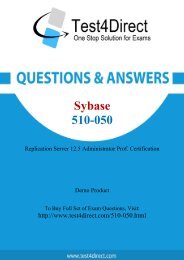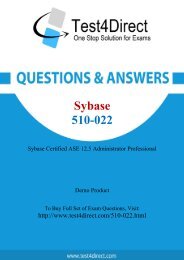98-365 Real Exam BrainDumps Updated 2016
Test4Direct provides latest PDF questions of Microsoft 98-365 exam. You have an opportunity to pass the Microsoft 98-365 exam in one go. Test4Direct is most accurate source to prepare Microsoft 98-365 exam as your success will become site’s responsibility after purchasing 98-365 exam product. There are also lots of discounts and promotion offers that you can avail. Let’s try a free demo http://www.test4direct.com/98-365.html
Test4Direct provides latest PDF questions of Microsoft 98-365 exam. You have an opportunity to pass the Microsoft 98-365 exam in one go. Test4Direct is most accurate source to prepare Microsoft 98-365 exam as your success will become site’s responsibility after purchasing 98-365 exam product. There are also lots of discounts and promotion offers that you can avail. Let’s try a free demo http://www.test4direct.com/98-365.html
Create successful ePaper yourself
Turn your PDF publications into a flip-book with our unique Google optimized e-Paper software.
Microsoft<br />
<strong>98</strong>-<strong>365</strong><br />
Windows Server Administration Fundamentals<br />
Demo Product<br />
To Buy Full Set of <strong>Exam</strong> Questions, Visit:<br />
http://www.test4direct.com/<strong>98</strong>-<strong>365</strong>.html
Question: 1<br />
A disaster recovery plan should contain data, hardware, and software that are critical for a business.<br />
Which of the following are disaster recovery planning steps?<br />
Each correct answer represents a complete solution. Choose all that apply.<br />
A. Prioritize business processes<br />
B. Monitor the plan<br />
C. Identify alternate sites<br />
D. Identify and assess the risks<br />
Question: 2<br />
Answer: D, A, and C<br />
Explanation:<br />
A disaster recovery plan should contain data, hardware, and software that are critical for a business.<br />
It should also include plans for a sudden loss, such as a hard disc crash. When putting together a<br />
disaster recovery plan, an organization should follow these steps:<br />
1.Identify and assess the risks.<br />
2.Prioritize business processes.<br />
3.Prioritize technology services.<br />
4.Define recovery strategies.<br />
5.Secure facilities.<br />
6.Identify alternate sites.<br />
7.Use redundancy and failover.<br />
8.Document the plan.<br />
9.Test the plan.<br />
10.Update the recovery plan.<br />
You work as a Server Administrator for company Inc. The company has a Windows 2008 R2 network<br />
environment. You need to install Windows Server Backup to back up registry information, domain<br />
controller configuration, and file systems of a domain controller. Choose and reorder the steps that<br />
you will take to accomplish the task.
Answer:<br />
Explanation:<br />
Take the following steps to install Windows Server Backup on Windows Server 2008 R2:<br />
1.Run Server Manager from Start > Administrative Tools > Server Manager.<br />
2.In the left pane of Server Manager, click the Features option.<br />
3.In the right pane, click the Add Features option. This will run Add Features Wizard.<br />
4.On the Select Features page of Add Features Wizard, select the Windows Server Backup checkbox<br />
in the Features listbox. Click the Next button.
5.On the Confirm Installation Selections page, select the Install button.<br />
6.The Installation Progress page will show the progress of the installation.
7.On the Installation Results page, click the Close button.<br />
Question: 3<br />
After the promotion of a computer to a domain controller, a user can use various MMC snap-in<br />
consoles to manage Active Directory. Which of these consoles are used for administering and<br />
publishing information in the directory, which includes managing users, groups, computers, domains,<br />
domain controllers, and organizational units?<br />
A. Active Directory Users and Computers<br />
B. Active Directory Sites and Services<br />
C. Active Directory Domains and Trusts<br />
D. Active Directory Administrative Center<br />
Answer: D<br />
Explanation:<br />
Active Directory Administrative Center console is used for administering and publishing information<br />
in the directory, which includes managing users, groups, computers, domains, domain controllers,<br />
and organizational units.<br />
Answer: A is incorrect. Active Directory Users and Computers console is used for managing users,<br />
groups, computers, and organizational units.<br />
Answer: C is incorrect. Active Directory Domains and Trusts console is used for administering domain<br />
trusts, domain and forest functional levels, and user principal name (UPN) suffixes.<br />
Answer: B is incorrect. Active Directory Sites and Services console is used for administering
eplication of directory data among all sites in an Active Directory Domain Services forest.<br />
Question: 4<br />
Which of the following statements are true about Resmon?<br />
Each correct answer represents a complete solution. Choose all that apply.<br />
A. It is used for parental control and filtering, and controls which Web sites can be visited and which<br />
programs can have Internet access.<br />
B. It is a system monitoring tool.<br />
C. It enables users to view and monitor complete resource information about their computer.<br />
D. It is a lightweight utility for local host monitoring that is queried by tools like nagios over http.<br />
Question: 5<br />
Answer: B, D, and C<br />
Explanation:<br />
Resmon is a system monitoring tool. It is a lightweight utility for local host monitoring that is queried<br />
by tools like nagios over http. It enables users to view and monitor complete resource information<br />
about their computer, similar to some of the features found in Task Manager.<br />
Answer: A is incorrect. iProtectYou is software that is used for parental control and filtering, and<br />
controls which Web sites can be visited and which programs can have Internet access. This tool can<br />
specify the access permission to users and groups on a computer. It also specifies words or phrases<br />
that will determine whether an email, Instant Message, Web site is blocked. It also blocks other sites<br />
that fall into specific categories, such as pornography, violence, etc. Certain newsgroups can also be<br />
blocked if they are not included in the database of child-safe groups.<br />
Which of the following statements best describe the functions of RD Connection Broker in network<br />
infrastructure? Each correct answer represents a complete solution. Choose two.<br />
A. It is used to permit a user to reconnect to his existing session in a load-balanced RD Session Host<br />
server farm.<br />
B. It is used to integrate with Hyper-V to provide virtual machines by using RemoteApp and Desktop<br />
Connection.<br />
C. It is used to redirect users to a shared virtual machine pool where a virtual machine is dynamically<br />
assigned.<br />
D. It is used to enable a user to evenly distribute the session load among RD Session Host servers in a<br />
load-balanced RD Session Host server farm.<br />
Answer: A and D<br />
Explanation:<br />
The various functions of RD Connection Broker are as follows:<br />
It is used to permit a user to reconnect to his existing session in a load-balanced RD Session Host<br />
server farm. It is used to enable a user to evenly distribute the session load among RD Session Host<br />
servers in a load-balanced RD Session Host server farm.<br />
It is used to provide users access to virtual desktops that are hosted on RD Virtualization Host servers<br />
and to RemoteApp programs that are hosted on RD Session Host servers using RemoteApp and<br />
Desktop Connection.
Answer: B and C are incorrect. Both of these are the functions of RD Virtualization Host.<br />
Question: 6<br />
You are working on a Windows 2008 environment. You find that some of applications are not<br />
responding while creating a project. You want to terminate these applications anyhow and start a<br />
new session. What will you do to accomplish the task?<br />
A. Use Device Manager.<br />
B. Use Network Monitor.<br />
C. Use System Monitor.<br />
D. Use Task Manager.<br />
Question: 7<br />
Answer: D<br />
Explanation:<br />
In order to accomplish the task, you should use Task Manager. A task manager is a program used to<br />
provide information about the processes and programs running on a computer, as well as the general<br />
status of the computer. It can also be used to terminate processes and programs, as well as change<br />
the processes priority. The task manager is most commonly accessed by pressing the buttons<br />
Control-Alt-Delete. Task manager also displays all the services that are currently running as well as<br />
those that were stopped. All information's about the services such as Process ID and their group if<br />
they are applicable.<br />
Answer: A is incorrect. Device Manager is a tool that can be used to manage devices on a computer.<br />
Using Device Manager, users can view and change device properties, update device drivers,<br />
configure device settings, and uninstall devices. Device Manager is organized in a tree format with<br />
the top branches representing device categories. Users can use Device Manager to identify port<br />
resource conflicts. Device Manager can also be used to enable or disable a device.<br />
Answer: C is incorrect. System Monitor is a Windows utility that enables users to monitor server<br />
activity and performance using predefined objects and counters or user-defined counters. It tracks<br />
items such as, I/O, memory usage, user connections, and locks. Although it can monitor the number<br />
of locks held, it cannot be used to capture information on particular locks and activities.<br />
Answer: B is incorrect. Network Monitor is a tool used to monitor data sent and received by the local<br />
computer. Network Monitor can perform the following functions:<br />
Capturing or tracing data and filtering it based on different attributes.<br />
Monitoring throughput based on bytes or frames.<br />
Monitoring bandwidth based on percentage of the network used.<br />
Monitoring errors, which can be a possible consequence of an overloaded network.<br />
You work as a Network Administrator for Perfect Solutions Inc. The company has a Windows Active<br />
Directory-based single domain single forest network. The functional level of the forest is Windows<br />
Server 2008. You are planning to create groups for assigning permissions. Drag and place the<br />
appropriate group in front of the group scopes that are given.
Answer:<br />
Explanation:<br />
The scope of a group defines two characteristics:<br />
It determines the level of security applying to a group.<br />
It determines which users can be added to a group.<br />
Windows Server 2008 supports the following scopes:<br />
Domain Local: Domain local groups are used to assign permissions to local resources such as files and<br />
printers. Members can come from any domain.<br />
Global: Members of this group can access resources in any domain. Members can only come from<br />
the local domain.<br />
Universal: Members can be added from any domain in the forest. Members can access resources<br />
from any domain. Universal groups are used for managing the security across domains. Universal<br />
groups can also contain global groups.<br />
Question: 8<br />
You work as a System Administrator for company Inc. The company has a Windows 2008 domainbased<br />
network. The network has 120 Windows 7 computers and two Windows Server 2008 R2<br />
servers. You want to ensure that when users log on to any client computer on the network, settings<br />
can be changed, but all settings are reset back to their default values when they log on again. What<br />
will you do to accomplish the task?<br />
A. Create a Group Policy Object.<br />
B. Create a local user profile.<br />
C. Create a roaming user profile.<br />
D. Create a mandatory user profile.<br />
Answer: D<br />
Explanation:<br />
In order to accomplish the task, you should create a mandatory user profile. A mandatory user profile<br />
is a preconfigured, read-only roaming user profile that administrators can use to specify settings for<br />
users in a Windows environment. With a mandatory user profile, a user can modify the desktop, but<br />
any changes made are not saved when the user logs off. The next time the user logs on, the
mandatory user profile set by the administrator is downloaded.<br />
Answer: B is incorrect. A local user profile is stored locally on the hard drive of the computer on<br />
which the user logs on. If the user logs on to a different computer, he gets the default settings for<br />
that computer.<br />
Answer: C is incorrect. A roaming user profile is stored in a centralized place and can be accessed<br />
from the network. When users log on to their computers, they receive the desktop setting as it<br />
existed when they logged off.<br />
Answer: A is incorrect. A Group Policy Object (GPO) is a collection of group policy settings. It affects<br />
the user and computer accounts located in sites, domains, and organizational units (OUs).<br />
Question: 9<br />
You work as a System Administrator for company Inc. You are configuring the iSCSI Initiator program<br />
in order to connect a host computer running Windows Server 2008 R2 to an external iSCSI-based<br />
storage array. Mark the tab or button that specifies the location of the SAN and Internet Storage<br />
Name Service (iSNS) servers when you open the iSCSI Initiator program.<br />
Answer:<br />
Explanation:<br />
When you open the iSCSI Initiator program, the Discovery tab specifies the location of the SAN and<br />
Internet Storage Name Service (iSNS) servers.
Question: 10<br />
Which of the following are the levels of printer permissions provided by Windows Server 2008?<br />
Each correct answer represents a complete solution. Choose all that apply.<br />
A. Manage documents<br />
B. Print<br />
C. Reload the printer<br />
D. Manage this printer<br />
Question: 11<br />
Question: 12<br />
Answer: B, D, and A<br />
Explanation:<br />
There are three levels of printer permissions provided by Windows Server 2008:<br />
Print: It permits users to send documents to the printer.<br />
Manage this printer: It permits users to modify printer settings and configurations.<br />
Manage documents: It gives the ability to cancel, pause, resume, or restart a print lob.<br />
Answer: C is incorrect. There is no such level of printer permission in Windows Server 2008 as reload<br />
the printer.<br />
You work as a System Administrator for company Inc. The company has a Windows 2008 based<br />
network environment. There are twenty client computers running Windows 7 and three servers<br />
running Windows server 2008 R2. You want to increase the data availability for these servers without<br />
rebuilding them and without investing a large amount of money for purchasing array controllers.<br />
What will you do?<br />
Each correct answer represents a part of the solution. Choose all that apply.<br />
A. Add another physical drive to each server.<br />
B. Convert the drives from basic disks to dynamic disks.<br />
C. Implement the RAID 1 solution between the two drives.<br />
D. Ensure that the backups are running smoothly.<br />
Answer: A, B, and C<br />
Explanation:<br />
In order to increase the data availability for the servers without rebuilding them and without<br />
investing a large amount of money for purchasing array controllers, you should do the following<br />
tasks:<br />
Add another physical drive to each server.<br />
Convert the drives from basic disks to dynamic disks.<br />
Implement the RAID 1 solution between the two drives.<br />
Answer: D is incorrect. Backups do not increase the data availability. They help you in restoring the<br />
original data after a data loss event.<br />
Which of the following servers is used to store and forward e-mail messages using several protocols,
including SMTP, POP3, and IMAP?<br />
A. File server<br />
B. Monitoring server<br />
C. Database server<br />
D. Mail server<br />
Question: 13<br />
Question: 14<br />
Answer: D<br />
Explanation:<br />
A mail server is a program used to store and forward e-mail messages using several protocols,<br />
including SMTP, POP3, and IMAP. A mail server is also recognized by the names, such as a mail<br />
transfer agent or MTA, a mail transport agent, a mail router, and an Internet mailer. It works with<br />
other programs to build a messaging system. The examples of mail servers are Netscape Messaging<br />
Server and Microsoft Exchange Server.<br />
Answer: C is incorrect. A database server is a computer program that provides database services to<br />
other computer programs or computers, as defined by the client-server model. The term may also<br />
refer to a computer dedicated to running such a program. Database management systems frequently<br />
provide database server functionality, and some DBMSs (e.g., MySQL) rely exclusively on the clientserver<br />
model for database access.<br />
Answer: A is incorrect. A file server on a network is a computer configured to provide a central<br />
network location for users to store files and share them with other users on the network.<br />
Answer: B is incorrect. A monitoring server is used to monitor the network and servers for intruders<br />
or other security breaches.<br />
You work as a Network Administrator for company Inc. The network of the company contains<br />
Windows Server 2008 R2 server and Windows 7 client computers. You have been assigned the task<br />
to connect printers to the server. Which of the following ports (on the server) will you use to<br />
accomplish the task?<br />
A. VGA port<br />
B. DVI-I port<br />
C. Parallel port<br />
D. PS/2 port<br />
Answer: C<br />
Explanation:<br />
Parallel port is considered as a legacy port that is used to connect printers.<br />
Answer: A is incorrect. VGA port is used for connecting a monitor to the computer.<br />
Answer: D is incorrect. PS/2 mouse port is used for connecting a legacy mouse.<br />
Answer: B is incorrect. DVI-I port is a high-quality video interface designed for replacing VGA ports.<br />
You work as a Network Administrator for Net Perfect Inc. The company has a Windows Server 2008<br />
network environment. The network is configured as a Windows Active Directory-based single forest<br />
network. You are configuring a new computer. You want to configure the computer's hard disk as a
dynamic disk. Which of the following command-line tools will you use to convert a hard disk from<br />
basic to dynamic?<br />
A. NTDSUTIL<br />
B. DISKPART<br />
C. FDISK<br />
D. FSUTIL<br />
Question: 15<br />
Answer: B<br />
Explanation:<br />
In order to accomplish the task, you will have to use the DISKPART command-line utility. A dynamic<br />
disk is a physical disk, which supports volumes that span multiple disks such as striped volume, RAID-<br />
5 volume, etc. A dynamic disk uses a hidden database to track information about dynamic volumes<br />
on the disk and other dynamic disks in the computer. Dynamic disks can be made by converting the<br />
basic disks. This can be done by using Disk Management or the DISKPART command-line utility.<br />
When a basic disk is converted into a dynamic disk, all existing basic volumes become dynamic<br />
volumes.<br />
Choose from the list below the tasks that you can do with the help of the Group Policy Management<br />
Console (GPMC).<br />
Answer:<br />
Explanation:<br />
GPMC enables a user to complete the following tasks:<br />
1.Create a new GPO: It is good measure to create new descriptive GPOs instead of modifying existing<br />
GPOs.<br />
2.Link a GPO: In the GPMC, right-click a container, click Link an Existing GPO, and select a GPO from<br />
the Group Policy Objects list.
3.Edit a GPO: In GPMC, right-click the GPO that a user wants to edit, and click Edit. The Group Policy<br />
Management Editor (GPME) opens so that a user can edit the computer and user configuration<br />
instantly. Any modifications made in the GPO are saved instantly.<br />
4.Back Up a GPO: In the GPMC, open the Group Policy Objects node, and right-click a GPO. Click Back<br />
Up and select a location in which to back up the GPO. Give the GPO an appropriate description. By<br />
default, the backup will use the GPO ID as the name for the backup folder. By using a description, the<br />
user makes it easier to identify the GPO in case he needs to restore it.<br />
5.Restore a GPO: In the GPMC Group Policy Object node, right-click the GPO that a user wants to<br />
restore, and click Restore From Backup. In the Restore Group Policy Object Wizard, select the backup<br />
location and the source GPO, and then finish the wizard.
THANKS FOR TRYING THE DEMO OF OUR PRODUCT<br />
Visit Our Site to Purchase the Full Set of Actual <strong>98</strong>-<strong>365</strong> <strong>Exam</strong> Questions With Answers.<br />
http://www.test4direct.com/<strong>98</strong>-<strong>365</strong>.html<br />
We Also Provide Practice <strong>Exam</strong> Software That Simulates <strong>Real</strong> <strong>Exam</strong> Environment And Has<br />
Many Self-Assessment Features. Download Free Product Demo From:<br />
http://www.test4direct.com/<strong>98</strong>-<strong>365</strong>.html<br />
Money Back Guarantee<br />
Check Out Our Customer Testimonials

















